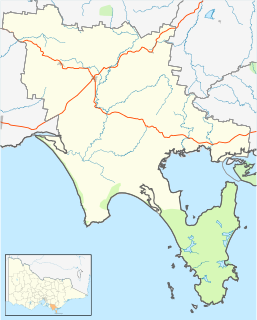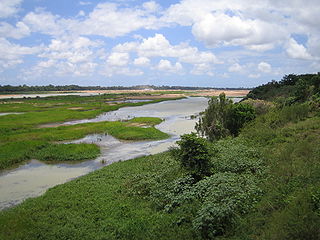
Diprotodon is an extinct genus of large marsupials native to Australia from the Pleistocene epoch. It is considered one of Australia's core species of "megafauna", which ranged throughout the continent during the Pleistocene. The genus is currently considered monotypic, containing only Diprotodon optatum, the largest known marsupial to have ever existed. The word diprotodon is constructed from the Ancient Greek words for 'two forward teeth'. Diprotodon existed from about 1.6 million years ago until extinction some 44,000 years ago.

Pelicans are a genus of large water birds that make up the family Pelecanidae. They are characterized by a long beak and a large throat pouch used for catching prey and draining water from the scooped-up contents before swallowing. They have predominantly pale plumage, except for the brown and Peruvian pelicans. The bills, pouches, and bare facial skin of all pelicans become brightly coloured before the breeding season. The eight living pelican species have a patchy global distribution, ranging latitudinally from the tropics to the temperate zone, though they are absent from interior South America and from polar regions and the open ocean.

The order Peramelemorphia includes the bandicoots and bilbies; it equates approximately to the mainstream of marsupial omnivores. All members of the order are endemic to the twin land masses of Australia-New Guinea and most have the characteristic bandicoot shape: a plump, arch-backed body with a long, delicately tapering snout, very large upright ears, relatively long, thin legs, and a thin tail. Their size varies from about 140 grams up to 4 kilograms, but most species are about one kilogram, or the weight of a half-grown kitten.

The Australian pelican is a large waterbird in the family Pelecanidae, widespread on the inland and coastal waters of Australia and New Guinea, also in Fiji, parts of Indonesia and as a vagrant in New Zealand. It is a predominantly white bird with black wings and a pink bill. It has been recorded as having the longest bill of any living bird. It mainly eats fish, but will also consume birds and scavenge for scraps if the opportunity arises.

Perameles is a genus of marsupials of the order Peramelemorphia. They are referred to as long-nosed bandicoots or barred bandicoots.

Palorchestes is an extinct genus of terrestrial, herbivorous marsupials of the family Palorchestidae. The genus was endemic to Australia, living from the Miocene through to the Pleistocene epochs.
Permotipula is an extinct monotypic genus of protodipteran insect which contains a single species Permotipula patricia. The only specimen of Permotipula was found in Late Permian strata of the Newcastle Coal Measures between the towns of Belmont and Warners Bay on the eastern side of Lake Macquarie, New South Wales, Australia and named by Robert J. Tillyard in 1929. The specimen consisting of a single well preserved wing, was considered lost after the death of Tillyard in 1937. The loss of the specimen and the mention by Tillyard of a second insects fossil from the same site, later described as Robinjohnia tillyardi resulted in much confusion regarding the taxonomic affiliations of P. patricia. Robinjohnia, a four winged insect which is now placed in the order Mecoptera. The P. patricia type specimen was found in the Tillyard collection which is housed at the British Museum and reexamined by R. Willmann in a 1989 paper. A second species, P. borealis was named by O.M. Martynova in 1961 from a small wing specimen found in the Kuznetsk Basin, Russia. This species was moved, however, in 1989 by R. Willmann to the monotypic genus Permila and is now considered a probable early mecopteran.

Archaeidae, also known as assassin spiders and pelican spiders, is a spider family with about ninety described species in five genera. It contains small spiders, ranging from 2 to 8 millimetres long, that prey exclusively on other spiders. They are unusual in that they have "necks", ranging from long and slender to short and fat. The name "pelican spider" refers to these elongated jaws and necks used to catch their prey. Living species of Archaeidae occur in South Africa, Madagascar and Australia, with the sister family Mecysmaucheniidae occurring in southern South America and New Zealand.

The eastern pygmy possum is a diprotodont marsupial of south-eastern Australia. Occurring from southern Queensland to eastern South Australia and also Tasmania, it is found in a range of habitats, including rainforest, sclerophyll forest, woodland and heath.
Australosuchus is an extinct genus of crocodylian belonging to the subfamily Mekosuchinae. The type and only known species Australosuchus clarkae lived during the Late Oligocene and the Early Miocene of southern Australia. The generic name Australosuchus means "Southern crocodile". It was described in 1991 from fossil material discovered at Lake Palankarinna in South Australia.

Elseya is a genus of large side-necked turtles, commonly known as Australian snapping turtles, in the family Chelidae. Species in the genus Elseya are found in river systems in northern and northeastern Australia and throughout the river systems of New Guinea. They are identified by the presence of alveolar ridges on the triturating surfaces of the mouth and the presence of a complex bridge strut.
Paleontology or palaeontology is the study of prehistoric life forms on Earth through the examination of plant and animal fossils. This includes the study of body fossils, tracks (ichnites), burrows, cast-off parts, fossilised feces (coprolites), palynomorphs and chemical residues. Because humans have encountered fossils for millennia, paleontology has a long history both before and after becoming formalized as a science. This article records significant discoveries and events related to paleontology that occurred or were published in the year 1966.
Leslie Reginald Cox FRS was an English palaeontologist and malacologist.
The Tingamarra Fauna is associated with the early Eocene Murgon fossil site, and contains the earliest known non-flying eutherian, passerine, trionychidae turtles, mekosuchine crocodiles along with frogs, lungfish and teleost fish in Australia. The Murgon fossil site is located near Kingaroy in south-east Queensland.

Inquisitor multilirata is a species of sea snail, a marine gastropod mollusk in the family Pseudomelatomidae.

Haustellum tweedianum, common name : the Tweed murex, is a species of sea snail, a marine gastropod mollusk in the family Muricidae, the murex snails or rock snails.

Koonwarra is a town in the South Gippsland region of Victoria, Australia. At the 2016 census, Koonwarra had a population of 404. The town straddles the South Gippsland Highway. Located around 128 km southeast of Melbourne, the town was served by rail from the 1890s until 1991 with the closing of the rail line to Barry Beach.

The Bluff Downs fossil site is a paleontological site of Pliocene age in northern Queensland, Australia. It is one of the most significant fossil sites of Pliocene age in Australia due to its unique fauna and specific dating. The fossil site lies on the banks of the Allingham Creek on the pastoral property of Bluff Downs Station, northwest of Charters Towers on the Cape York Peninsula
The Keilor archaeological site was among the first places to demonstrate the antiquity of Aboriginal occupation of Australia when a cranium, unearthed in 1940, was found to be nearly 15,000 years old. Subsequent investigations of Pleistocene alluvial terraces revealed hearths about 31,000 years BP, making Keilor one of the earliest sites of human habitation in Australia. Remains of megafauna suggest a possible association with Aboriginal hunting.
Pelecanus cadimurka is a fossil pelican from the Late Pliocene Kanunka fauna of the upper Tirari Formation, in the Lake Eyre basin of north-eastern South Australia.












